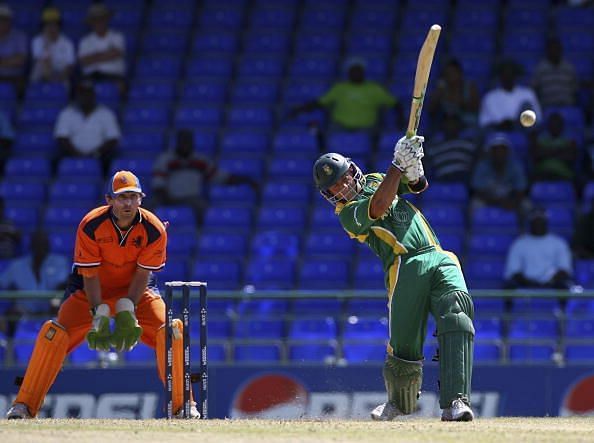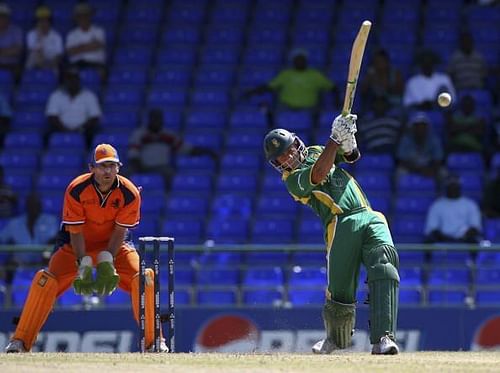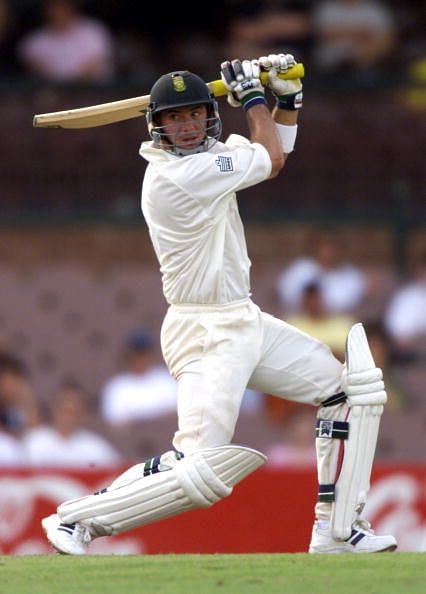
Cricket World Cup history: Herschelle Gibbs, twin asset with willow and in the field

Fleet-footed, hawk-eyed and endowed with lightning reflexes, Herschelle Gibbs is the archetypal natural sportsman. The first coloured cricketer to command a regular place in the South African team, he was one of the most exciting, uncomplicated players in the modern game. Not for him complex theories, for he played by instinct. An exhilarating batsman in both forms and one of the best outfielders ever, Gibbs was a twin asset to his side.
The first two legends of South African fielding were Colin Bland and Jonty Rhodes. Gibbs was the third. If Bland’s impromptu exhibition of knocking down the stumps from the cover boundary during rain breaks enthralled spectators in the sixties, Rhodes’ amazing swiftness at backward point set hitherto unimagined benchmarks in the nineties. That the careers of Rhodes and Gibbs overlapped, gave South Africa a massive advantage. If Rhodes wrought magic square on the off-side, Gibbs prowled at short mid-wicket, keeping batsmen on tenterhooks, cutting out scoring opportunities and covering huge expanses of turf. They cut out runs by the thousands and ran out batsmen by the scores. It was a most fascinating twin act.
Cricket’s history is replete with great pairs of fast bowlers, opening batsmen, spinners, even middle-order batsmen. Here was a great pair of fieldsmen. Rhodes and Gibbs must rank alongside Lillee and Thomson, Hobbs and Sutcliffe, Bedi and Prasanna, Lloyd and Richards, and all those other brilliant pairs of cricketers.
Rhodes’ fielding put his batting in the shade. In Gibbs’ case, probably the opposite is true, for his brilliance at the top of the order was the focus of attention. A sharp eye enabled him to spot the line and length very quickly, and he tended to pick up the ball early on the bounce and hit it off the front foot generally between wide long-on and square-leg, but often through the off-side too. It was akin to a Jimmy Connors return of serve, dealing early with the quickly travelling ball — before it bounced too high — and put away effectively and aggressively. That is what enabled Gibbs to score fast, and is a sure sign of a natural, instinctive sportsman.
He began with a couple of failures, like most opening batsmen who struggled in the seam-friendly early English summer of 1999. Gibbs then raised this World Cup’s first century opening stand, attacking the hosts in tandem with his long-standing partner Gary Kirsten. They hoisted the hundred in 20.1 overs, before the nagging medium-pace of Mark Ealham shackled them. At 111, Gibbs swept the puny bowler high over square-leg for Graeme Hick to take a brilliant catch diving forward. He departed for 60 off 94 deliveries, having hit 6 boundaries and a six. Ealham had Kirsten caught behind a run later for 45. But they had already posted enough runs. All the English batsmen put together could not total so many.
The Kenyans did not pose a serious challenge. Gibbs and Kirsten brought up a half-century stand as the Proteas cantered to a seven-wicket win. Gibbs hit up a-run-a-ball 38, studded with 4 fours and a six.
But it was in the latter stages of the event that he really came into his own. With the race for the semi-finals on in real earnest, the opening partnership was once again in overdrive. This time Kirsten kept pace with Gibbs as they set about decimating the New Zealand bowling. They began steadily, running the singles well and opened out once set. The score mounted. Another century stand was notched up. It was 176 when Kirsten departed for 82. Gibbs also missed his century, bowled by Geoff Allott, to give the left-arm pacemen his 19th wicket, the highest thus far in any single World Cup. Gibbs’ 91 off 118 deliveries was embellished with 6 fours and a six. It was just the platform for Jacques Kallis and Hansie Cronje to cash in on. The Kiwis were never in the frame from then on.
The real drama was now about to unfold. The Australians were waging a tremendous battle to qualify for the semi-finals. Gibbs hit up a magnificent hundred. Aware of the significance of the occasion, he once again allowed himself to settle in before unleashing his splendid array of shots. He put on 45 with Kirsten, and 95 in the company of Daryl Cullinan. Jonty Rhodes joined Gibbs at 141 for three and the run-rate climbed. They added 78 before Gibbs was castled by Glenn McGrath for 101. He had hit 10 fours and a six in a 134-ball knock. Lance Klusener’s customary pyrotechnics followed, and South Africa piled up 271.

Australia had been pushed against the wall. When they slumped to 48 for three, their exit appeared to be in sight. Steve Waugh joined Ricky Ponting and waged a struggle that was mighty even by his own standards. The pair had already put up a century stand when, at 152 for three in the 31st over, the skipper flicked Klusener straight into the hands of Gibbs. The star fieldsman pouched it effortlessly and instantaneously started to celebrate. Instead, the ball slipped as if coated with grease. One of the world’s best fielders had dropped a sitter, giving a new lease of life to an iconic warrior, a cricketing sin that invokes harsh punishment.
Waugh was then on 56. He marched on, mowing down everything in sight. He led his side to an incredible win by five wickets off the fourth delivery of the last over. Waugh was unconquered with 120, and Gibbs a picture of despair. A moment of impetuosity had snatched away the glory that seemed to be his only a couple of hours earlier.
The lapse was to have deeper consequences than the South Africans would have realised at that stage. The semi-final between the same teams four days later ended in a tie. The Proteas were knocked out because they had lost the previous match. A small slip had shattered a big dream. Gibbs scored 30 in a 48-run stand with Kirsten before Shane Warne ripped through. Gibbs, nevertheless, made a fine impression in the tournament and learnt a few lessons as well. Victory and defeat, triumph and ignominy are but two sides of the same coin.
The tale was somewhat similar in 2003, but the context different. Gibbs was in brilliant form but the team floundered, unable to advance to the super-six in a tournament South Africa had organised with such enthusiasm. But there was another story that shook South African cricket much before that. In 2000, Hansie Cronje was found to be at the centre of a match-fixing imbroglio, and Gibbs had a bit part in it too. Cronje never played again and lost his life in tragic circumstances. Gibbs was banned for a while, but to his credit, returned stronger than ever. He had faced trying times early in his career but showed character in fighting his way to the top.
Charisma Continues
By 2002 he was one of the top-ranking players in the world. In the 2003 World Cup he dazzled as seldom before. Faced with a daunting West Indies score of 278, and with one over taken off their innings, Gibbs and Kirsten made a brisk start. But Gibbs was caught behind off Mervyn Dillon for 24. Despite some valuable contributions down the order, South Africa were upstaged.
At that stage of the tournament nobody took Kenya seriously, and South Africa, despite the setback against the West Indies, were still rated as one of the favourites. The Proteas’ ten-wicket win was considered a formality and a reflection of the fact that the outfit was again in fine fettle. The old firm of Kirsten & Gibbs was doing roaring business. They knocked up 142 in 21.2 overs. Gibbs slammed the bowlers all around the ground for 87 off just 66 balls with 12 hits to the ropes and four over it.
Gibbs took guard to the New Zealand bowlers from where he had left off against Kenya. For some reason Kirsten did not partner him. It was Graeme Smith instead. The new pair raised 60 before Smith left. That set the tone, for Gibbs had a succession of useful partnerships. All this while he played a glorious innings, bringing up his 12th One-day hundred off 121 deliveries. He was awesome on this day, slamming left-armer Daniel Vettori for four boundaries in his tenth over. He was finally out for 143, having faced 141 balls in an essay embellished with 19 fours and 3 sixes. South Africa passed the 300 mark and their campaign now appeared well and truly on cue.
Rain interrupted the New Zealand innings and the Duckworth-Lewis method came into play. Overshadowing all else, the Kiwi captain Stephen Fleming was playing perhaps the innings of his life. Opening the batting, he put on 89 with Craig McMillan, but Mark Boucher grassed a simple chance offered by him when on 53. Fleming cracked an unbeaten 134 to race to the truncated target. South Africa lost by 9 wickets, their dreams once again in tatters.
There were some uncanny parallels here to that game against Australia at Edgbaston four years earlier. Steve Waugh was dropped in the fifties, with an easy catch going down, and the skipper went on to score a breathtaking unbeaten century to clinch a vital victory. The same thing happened with Fleming. Gibbs scored glittering hundreds in both matches, but finished on the losing side. Ecstasy and despair seemed to visit him hand-in-hand. Gibbs’ innings was now the highest for a losing team in the World Cup, leaving behind Zimbabwean David Houghton’s 142 in 1987.
The Bangladesh game was a stroll in Goodyear Park. His old associate Kirsten was by his side once more, and the firm registered a ten-wicket win. They rattled up the 109 required in 12 overs. While Kirsten scored 52 off 32 balls, Gibbs returned with 49 off 40 deliveries, having rocketed 8 fours and a six.
There was a rare failure for Gibbs against Canada. That was inconsequential, the big battle still ahead as South Africa took on Sri Lanka in the last pool match in a do-or-die situation.
Sri Lanka raised a formidable 268 in the day-night encounter at Kingsmead. Gibbs knocked up 65 with Smith in 11 overs, and carried on as none of his other partners was able to lend durable support. Gibbs was eventually bowled round his legs by Muttiah Muralitharan for a splendid 73 off 88 balls, having hit 7 fours and 2 sixes.
Rain added another twist and changed the equation. Ultimately, South Africa thought they had won, but later learnt to their horror that they had only tied the match, and were knocked out. South Africa were not destined to excel in this tournament. That is what it augured from the very first day. Gibbs’ brilliance was not to come to fruition yet one more time.
The Dutch amateurs had the misfortune of running into a South African team in prime form in the 2007 World Cup. Gibbs walked in after skipper Graeme Smith and Jacques Kallis had been associated in a century stand for the second wicket. Gibbs gradually built up momentum, and in the 29th over lofted Luuk van Troost over long-off for a six.
There was carnage in the next over. Gibbs slammed leg-spinner Daan van Bunge over the ropes at long-on. He went over the long-off boundary next ball. The third one also soared high in the next direction. Van Bunge then sent down a low full-toss, which Gibbs swung over the mid-wicket boundary. The fifth delivery was short and Gibbs flat-batted it beyond the long-off fence. There was one ball to go, which was pitched outside off, but Gibbs swiped it across the line with brute force and sent it sailing well clear of the mid-wicket boundary. Gibbs became the first man to hit 6 sixes in an over in One-day Internationals.
The legendary Gary Sobers and the unlikely Ravi Shastri had done it in first-class cricket. The maverick Yuvraj Singh emulated the feat in the 2007 ICC World Twenty20.
After trouncing van Troost for a four, Gibbs skipped down the pitch for another big hit, but only mistimed it into the hands of long-on. He had smashed 72 off a mere 40 deliveries, crashing 4 boundaries besides his 7 sixes. The partnership with Kallis was worth 105 in less than 12 overs. It was indeed lambs to the slaughter. The end result was a 221-run win.
There was no opportunity to bat against Scotland, and he failed to make an impression in the faceoff with Australia.
In their crucial encounter in the super- eights, Sri Lanka were all out for 209 in the last over. Smith and Kallis put on 94 for the second wicket. Gibbs then helped Kallis add 65. At 160 for two, South Africa were sailing. There were another 50 runs to get in 18 overs. Then there was mayhem. The irrepressible Muralitharan dismissed Gibbs for 32, and Boucher off the very next delivery. A little later Lasith Malinga grabbed four wickets off successive balls. Suddenly it was 207 for nine. The last pair just about managed to eke out a win.
Following a failure against Ireland, Gibbs was able to bat only at no.7 due to a calf strain after Bangladesh had put up a solid total of 251 for eight. He came in, runner Ashwell Prince in tow, with South Africa tottering at 87 for five in the 27th over. He saw Justin Kemp depart off the very next delivery from the young left-armer Shakib Al Hasan. A partnership of 45 with Shaun Pollock in 9 overs too did not ease the pressure much. Then wickets began to tumble and the Proteas were upset by 67 runs. Gibbs was unbeaten with 56, having faced 59 balls, and hit a boundary in addition to a six each off Shakib and paceman Mashrafe Mortaza.
There was a need to regroup after that setback. Abraham de Villiers and Kallis put on 170 for the second wicket against the West Indies. Gibbs helped de Villiers add 70 in less than 8 overs. After de Villiers departed for a superb 146, Gibbs went into overdrive. He crashed left-arm seamer Ian Bradshaw straight and high to the boundary, and then rocketed him for 2 sixes on the on-side, all in the same over. With Mark Boucher also getting into the act it was mayhem. Together they trounced paceman Darren Powell
For 4 sixes in an over, Gibbs accounting for one of them, which got him to his fifty off 35 balls. Boucher followed with the then fastest half-century in 22 deliveries. Their partnership was worth 86 in 6.1 overs. Gibbs remained unbeaten with 61, having faced just 40 balls and carved 4 boundaries besides the 3 sixes. South Africa raced to 356 for four, their highest total in the World Cup. It was too much for the hosts to chase.
The pendulum swung again as the New Zealand pacemen sent back the openers with just 3 runs on the board. Gibbs retrieved the situation somewhat with Kallis in a stand of 49, and then with Prince in a partnership of 76. He top-scored with 60, but the Proteas could not post a challenging total.
Yet again the situation was reversed as England were unable to put up a score that would test the Proteas. Gibbs did not get a chance to wield his willow.
The semi-final faceoff was against the unstoppable Aussies. The Proteas batting crumbled, though Gibbs tried to battle it out. He was in at 12 for two and soon saw his side slump to 27 for five. Justin Kemp helped him add 60 in 13 overs, but Gibbs edged one to Adam Gilchrist behind the stumps off the pacy Shaun Tait. He was gone for 39, scored off 49 deliveries and having struck 6 boundaries. Australia marched on.
It was a fine World Cup for Gibbs. He had scored 342 runs in 8 innings at an average of 57, a strike-rate of 91.68 and hit 4 fifties, and his 7 catches were a huge bonus. Sometimes annihilating the opposition, at other times fighting with his back to the wall, Gibbs was a key element in South Africa reaching the semi-finals.
He became South Africa’s first batsman to aggregate 1000 runs in the World Cup with an average above 56, and strike-rate over 87. Herschelle Gibbs has been somewhat of a tragic hero for South Africa in the World Cup. On a couple of occasions when he sparkled, the team faltered, and someone else cornered the limelight. At his peak, Herschelle Gibbs was exhilarating to watch, with the bat and on the field.
Herschelle Gibbs’ World Cup batting and fielding record:
Matches 25, Highest Score 143, Runs 1067, Average 56.15, Strike-rate 87.38, Hundreds 2, Fifties 8, Catches 10